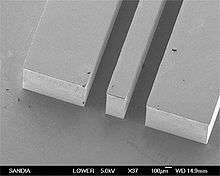Coplanar waveguide

Coplanar waveguide is a type of electrical transmission line which can be fabricated using printed circuit board technology, and is used to convey microwave-frequency signals. On a smaller scale, coplanar waveguide transmission lines are also built into monolithic microwave integrated circuits. Conventional coplanar waveguide (CPW) consists of a single conducting track printed onto a dielectric substrate, together with a pair of return conductors, one to either side of the track. All three conductors are on the same side of the substrate, and hence are coplanar. The return conductors are separated from the central track by a small gap, which has an unvarying width along the length of the line. Away from the cental conductor, the return conductors usually extend to an indefinite but large distance, so that each is notionally a semi-infinite plane.
Conductor-backed coplanar waveguide (CBCPW) is a common variant which has a ground plane covering the entire back-face of the substrate. The ground-plane serves as a third return conductor.
The electromagnetic wave carried by a coplanar waveguide exists partly in the dielectric substrate, and partly in the air above it. In general, the dielectric constant of the substrate will be different (and greater) than that of the air, so that the wave is travelling in an inhomogeneous medium. In consequence CPW will not support a true TEM wave; at non-zero frequencies, both the E and H fields will have longitudinal components (a hybrid mode).
See also
- Waveguide (electromagnetism)
- Microstrip
- Stripline
- Post-wall waveguide
- Telegrapher's equations
- Via fence
References
- ↑ Forman, M. A. (December 2006). "Low-loss LIGA-fabricated coplanar waveguide and filter". Apmc 2006. 12: 905–1907.
External links
- Coplanar waveguide circuits, components and systems (Rainee N. Simons - Wiley series in microwave and optical engineering ; Year 2001 ; ISBN 0-471-16121-7)
